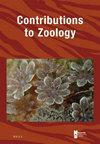Fungia fungites (Linnaeus, 1758) (Scleractinia, Fungiidae) is a species complex that conceals large phenotypic variation and a previously unrecognized genus
IF 2.1
2区 生物学
Q1 ZOOLOGY
引用次数: 6
Abstract
Recent molecular phylogenetic analyses of scleractinian corals have resulted in the discovery of cryptic lineages. To understand species diversity in corals, these lineages need to be taxonomically defined. In the present study, we report the discovery of a distinct lineage obscured by the traditional morphological variation of Fungia fungites. This taxon exists as two distinct morphs: attached and unattached. Molecular phylogenetic analyses using mitochondrial COI and nuclear ITS markers as well as morphological comparisons were performed to clarify their phylogenetic relationships and taxonomic positions. Molecular data revealed that F. fungites consists of two genetically distinct clades (A and B). Clade A is sister to a lineage including Danafungia scruposa and Halomitra pileus, while clade B formed an independent lineage genetically distant from these three species. The two morphs were also found to be included in both clades, although the attached morph was predominantly found in clade A. Morphologically, both clades were statistically different in density of septal dentation, septal number, and septal teeth shape. These results indicate that F. fungites as presently recognized is actually a species complex including at least two species. After checking type specimens, we conclude that specimens in clade A represent true F. fungites with two morphs (unattached and attached) and that all of those in clade B represent an unknown species and genus comprising an unattached morph with only one exception. These findings suggest that more unrecognized taxa with hitherto unnoticed morphological differences can be present among scleractinian corals.真菌门真菌门(Linnaeus,1758)(菌核菌门,真菌科)是一个复杂的物种,隐藏着巨大的表型变异和一个以前未被识别的属
最近对巩膜珊瑚的分子系统发育分析已经发现了隐谱系。为了了解珊瑚的物种多样性,需要对这些谱系进行分类定义。在本研究中,我们报告了一个被真菌的传统形态变异所掩盖的独特谱系的发现。该分类单元以两种不同的形态存在:附着和未附着。利用线粒体COI和核ITS标记进行分子系统发育分析,并进行形态学比较,以阐明它们的系统发育关系和分类位置。分子数据显示,真菌F.由两个基因上不同的分支(A和B)组成。分支A是一个谱系的姐妹,包括Danafungia acrososa和Halomitra pilus,而分支B形成了一个独立的谱系,在基因上与这三个物种相距甚远。这两种变体也被发现包含在两个分支中,尽管附着变体主要出现在分支A中。从形态学上讲,两个分支在间隔齿密度、间隔数量和间隔齿形状方面存在统计学差异。这些结果表明,目前公认的真菌实际上是一个包括至少两个物种的物种复合体。在检查了模式标本后,我们得出结论,分支A中的标本代表了具有两种形态(未附着和附着)的真正真菌,分支B中的所有标本都代表了一个未知物种和属,包括一个未附着的形态,只有一个例外。这些发现表明,巩膜珊瑚中可能存在更多未被识别的类群,这些类群具有迄今为止未被注意到的形态差异。
本文章由计算机程序翻译,如有差异,请以英文原文为准。
求助全文
约1分钟内获得全文
求助全文
来源期刊

Contributions to Zoology
生物-动物学
CiteScore
4.00
自引率
4.50%
发文量
16
审稿时长
>12 weeks
期刊介绍:
Contributions to Zoology solicits high-quality papers in all systematics-related branches of comparative zoology (including paleozoology). Preference will be given to manuscripts dealing with conceptual issues and to integrative papers (e.g., ecology and biodiversity, morphology and phylogeny and character state evolution, phylogeny and historical biogeography, systematics and bioinformatics, bioinformatics and biodiversity, habitat disturbance and biogeography, etc.). Reviews and alpha-taxonomic contributions are considered for publication, but acceptance will depend on their high quality and exceptional nature.
 求助内容:
求助内容: 应助结果提醒方式:
应助结果提醒方式:


